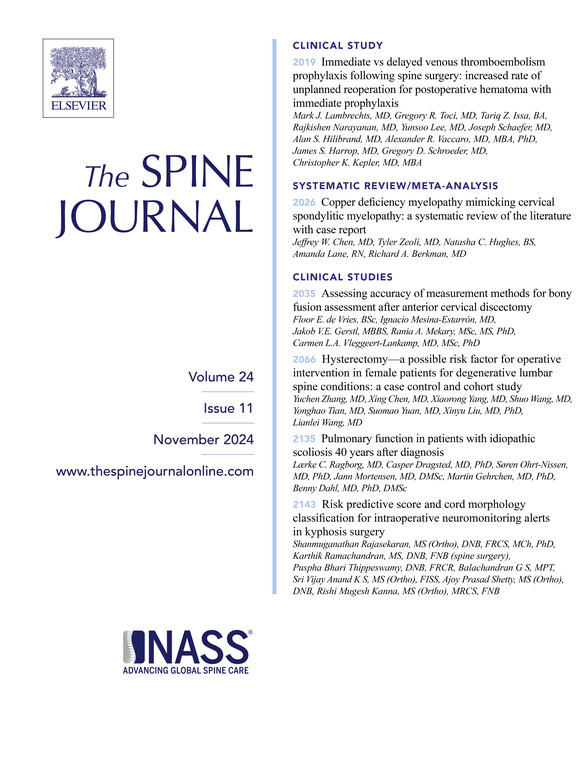椎板成形术配合椎板切除术与前路颈椎椎间盘切除术和融合术治疗颈椎病
IF 4.9
1区 医学
Q1 CLINICAL NEUROLOGY
引用次数: 0
摘要
背景 CONTEX前路颈椎椎间盘切除融合术(ACDF)联合钩突切除术和椎板成形术联合椎板切除术(LPF)已被用于实现合并颈髓脊髓病(CMR)患者的颈髓和颈根减压。目的比较 ACDF 和 LPF 治疗 CMR 的临床和影像学结果:结果测量C2-C7前凸、C2-C7矢状纵轴和颈椎活动范围(ROM)。分析了颈部和手臂疼痛的视觉模拟量表(VAS)评分、颈部残疾指数(NDI)和日本骨科协会(JOA)评分。结果采用纳入标准和倾向评分匹配后,纳入了84名患者(每组42人)。LPF组和ACDF组的C2-C7前凸(p<0.001)和ROM(p<0.001)分别明显减少。LPF与C2-C7前凸的显著减少有关(p<0.001),而ACDF则导致颈部ROM的显著减少(p<0.001)。ACDF 有效改善了颈部疼痛 VAS(p<0.001)和 NDI(p<0.001),而 LPF 后颈部疼痛没有明显改善(p=0.103)。此外,术后6个月时,LPF组的颈部疼痛VAS(p=0.026)和NDI(p=0.021)明显高于ACDF组,而术后2年时的差异无统计学意义(颈部疼痛VAS,p=0.502;NDI,p=0.085)。LPF(p=0.003和0.043)或ACDF(p<0.001和0.039)术后手臂疼痛VAS和JOA评分均明显改善,两组术后结果无显著差异。结论LPF和ACDF对手臂疼痛和神经恢复的效果相似,ACDF对颈部疼痛的改善更为立竿见影,而LPF组和ACDF组术后2年后的颈部疼痛情况相似。此外,LPF 组术后前凸增加,而 ACDF 组术后 ROM 减少。在为CMR患者决定手术方法时应考虑这些发现。本文章由计算机程序翻译,如有差异,请以英文原文为准。
Laminoplasty with foraminotomy versus anterior cervical discectomy and fusion for cervical myeloradiculopathy
BACKGROUND CONTEXT
Anterior cervical discectomy and fusion (ACDF) combined with uncinate process resection and laminoplasty combined with foraminotomy (LPF) have been used to achieve cervical cord and root decompression in patients with combined cervical myeloradiculopathy (CMR).
PURPOSE
To compare the clinical and radiographic outcomes of ACDF with those of LPF for the treatment of CMR.
STUDY DESIGN/SETTING
Propensity score-matched retrospective cohort study.
PATIENT SAMPLE
Patients with CMR who underwent ACDF or LPF and were followed up for at least 2 years.
OUTCOME MEASURES
C2–C7 lordosis, C2–C7 sagittal vertical axis, and cervical range of motion (ROM) were determined. The visual analog scale (VAS) scores for neck and arm pain, neck disability index (NDI), and Japanese Orthopedic Association (JOA) scores were analyzed.
METHODS
The radiographic and clinical outcomes of the 2 groups were compared.
RESULTS
Eighty-four patients were included (n=42 in each group) after application of the inclusion criteria and propensity score matching. A significant decrease in C2–C7 lordosis (p<.001) and ROM (p<.001) was observed in the LPF and ACDF groups, respectively. LPF was associated with a significant decrease in C2 to C7 lordosis (p<.001), while ACDF caused a significant decrease in cervical ROM (p<.001). ACDF effectively improved neck pain VAS (p<.001) and NDI (p<.001), while neck pain did not significantly improve after LPF (p=.103). Furthermore, neck pain VAS (p=.026) and NDI (p=.021) at postoperative 6 months, were significantly greater in the LPF group than in the ACDF group, while the difference was not statistically significant at 2 years postoperatively (neck pain VAS, p=.502; NDI, p=.085). Arm pain VAS and JOA score both significantly improved after LPF (p=.003 and 0.043, respectively) or ACDF (p<.001 and 0.039, respectively), and postoperative results were not significantly different between the 2 groups.
CONCLUSION
LPF and ACDF yielded similar outcomes for arm pain and neurological recovery. More immediate neck pain improvement was observed with ACDF, while neck pain after 2 years postoperatively was similar between the LPF and ACDF groups. Furthermore, increased postoperative loss of lordosis was observed in the LPF group, whereas decreased postoperative ROM was observed in the ACDF group. These findings should be considered when deciding the surgical method for patients with CMR.
LEVEL Of EVIDENCE
III.
求助全文
通过发布文献求助,成功后即可免费获取论文全文。
去求助
来源期刊

Spine Journal
医学-临床神经学
CiteScore
8.20
自引率
6.70%
发文量
680
审稿时长
13.1 weeks
期刊介绍:
The Spine Journal, the official journal of the North American Spine Society, is an international and multidisciplinary journal that publishes original, peer-reviewed articles on research and treatment related to the spine and spine care, including basic science and clinical investigations. It is a condition of publication that manuscripts submitted to The Spine Journal have not been published, and will not be simultaneously submitted or published elsewhere. The Spine Journal also publishes major reviews of specific topics by acknowledged authorities, technical notes, teaching editorials, and other special features, Letters to the Editor-in-Chief are encouraged.
 求助内容:
求助内容: 应助结果提醒方式:
应助结果提醒方式:


